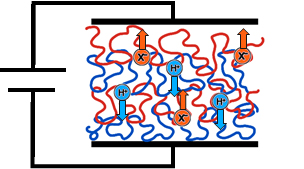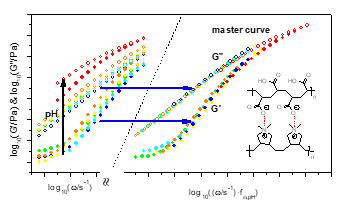Polyelectrolyte Self-Assembly: Multilayers, Coacervates and Hydrogels
The ‘Layer-by-layer’ (LbL) method allows the self-assembly of polyelectrolyte multilayers by alternating adsorption of polyanions and polycations to interfaces, providing a route towards versatile materials with structures defined on a nanometer scale. Such ultrathin LbL-films are allowing incorporation of various molecular or ionic constituents. In particular, we include various functionalities into LbL films towards potential applications. Examples are selective binding sites for small molecules formed by surface molecular imprinting, Au nanoparticles yielding films with humidity-tunable electronic conductivity, and weak polyacids allowing manipulation of the charge balance by pH variation to control ion content and ionic conductivity.
Furthermore, from the more fundamental angle of polymer physics, we are investigating dynamics and transport processes in ionic 3D polymer systems. Polyelectrolyte complexes formed from polycations and polyanions are the analogue 3D material to multilayers. They can form solid complexes or strongly water-swollen complex coacervate phases. Frequency-dependent rheology and impedance spectroscopy data deliver detailed dynamic information, leading to general laws, such as time-temperature superposition, or, in analogy, novel time-humidity superposition or time-pH superposition laws were identified. Currently we extend these activities to biopolymer systems and other types of (for example self-healing) hydrogels.



